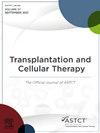Training in Transplantation and Cellular Therapy in Latin America: A Cross-Sectional Study of the LABMT
IF 3.6
3区 医学
Q2 HEMATOLOGY
引用次数: 0
Abstract
Hematopoietic cell transplantation (HCT) is a complex and resource-intensive procedure that has become a critical treatment for certain hematologic conditions. However, in Latin America, access to HCT is limited compared to high-income countries, in part due to a lack of standardized training programs for HCT professionals. To address this gap, the Latin-American Bone Marrow Transplantation Group conducted a cross-sectional study to assess the current state of training programs in HCT and cellular therapy across the region. This study aimed to describe and analyze the availability, characteristics, and challenges of HCT training programs in Latin America, with a focus on identifying barriers and proposing solutions for improvement. A cross-sectional survey was sent to 127 recognized HCT centers across 14 Latin-American countries in December 2022. The survey collected data on institutional characteristics, training program structure, costs, and barriers to program development. Descriptive statistics were used to summarize the data, and comparative analyses were performed using Chi-square and Mann–Whitney tests. Of the 127 centers surveyed, 50 (39%) responded, with the majority located in Brazil (34%) and Mexico (30%). Among the respondents, 64% (n = 32) offered formal training programs lasting 6 months or longer. The most significant barriers reported were lack of funding (n = 21), limited number of transplant procedures (n = 15), and a shortage of qualified professors (n = 11). Proposed solutions included increasing student mobility opportunities (n = 28), enhancing program quality (n = 27), and improving access to funding (n = 15). Only 6% of programs offered exposure to CAR-T therapy, and fewer than half of the centers provided international rotations. This study highlights significant disparities in HCT training programs across Latin America, with most countries lacking access to formalized training. While Brazil and Mexico serve as regional hubs, other nations have limited or no training opportunities. Addressing these gaps through increased funding, international collaborations, and standardized curricula is essential to improving HCT training and ultimately patient care in the region.
拉丁美洲的移植和细胞治疗培训:拉丁美洲移植和细胞治疗培训:LABMT 横向研究》:LABMT 调查。
背景:造血细胞移植(HCT)是一种复杂的资源密集型手术,已成为治疗某些血液病的重要方法。然而,在拉丁美洲,与高收入国家相比,获得造血干细胞移植的机会有限,部分原因是缺乏对造血干细胞移植专业人员的标准化培训计划。为弥补这一不足,拉丁美洲骨髓移植小组(LABMT)开展了一项横断面研究,以评估该地区造血干细胞移植和细胞疗法培训项目的现状:本研究旨在描述和分析拉丁美洲造血干细胞移植培训项目的可用性、特点和挑战,重点是找出障碍并提出改进方案:研究设计:2022 年 12 月,我们向 14 个拉美国家的 127 个公认的造血干细胞移植中心进行了横向调查。调查收集了有关机构特点、培训项目结构、成本和项目发展障碍的数据。采用描述性统计对数据进行总结,并使用卡方检验和曼-惠特尼检验进行比较分析:在接受调查的 127 家中心中,有 50 家(39%)做出了回应,其中大部分位于巴西(34%)和墨西哥(30%)。受访者中,64%(32 人)提供为期 6 个月或更长时间的正规培训计划。据报告,最主要的障碍是缺乏资金(21 人)、移植手术数量有限(15 人)和合格教授短缺(11 人)。建议的解决方案包括增加学生流动机会(人数=28)、提高项目质量(人数=27)和改善资金获取途径(人数=15)。只有6%的项目提供CAR-T疗法的接触机会,不到一半的中心提供国际轮转:本研究强调了拉丁美洲国家在 HCT 培训项目方面存在的巨大差异,大多数国家缺乏正规的培训机会。虽然巴西和墨西哥是地区中心,但其他国家的培训机会有限或根本没有。通过增加资金、国际合作和标准化课程来弥补这些差距,对于改善该地区的造血干细胞培训并最终改善患者护理至关重要。
本文章由计算机程序翻译,如有差异,请以英文原文为准。
求助全文
约1分钟内获得全文
求助全文
来源期刊

Transplantation and Cellular Therapy
Medicine-Hematology
CiteScore
7.00
自引率
15.60%
发文量
1061
审稿时长
51 days
 求助内容:
求助内容: 应助结果提醒方式:
应助结果提醒方式:


